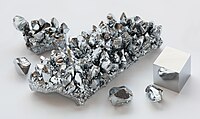
Photo from wikipedia
Articular cartilage is a remarkable material with mechanical performance that surpasses engineering standards. Collagen, the most abundant protein in cartilage, plays an important role in this performance, and also in… Click to show full abstract
Articular cartilage is a remarkable material with mechanical performance that surpasses engineering standards. Collagen, the most abundant protein in cartilage, plays an important role in this performance, and also in disease. Building on observations of network-level collagen changes at the earliest stages of osteoarthritis, this study explores the physical role of the collagen fibril in the disease process. Specifically, we focus on the material properties of collagen fibrils in the cartilage surface. Ten human tibial plateaus were characterised by atomic force microscopy (AFM) and Raman spectroscopy, with histological scoring used to define disease state. Measures of tropocollagen remained stable with disease progression, yet a marked mechanical change was observed. A slight stiffening coupled with a substantial decrease in loss tangent suggests a physical embrittlement caused by increased inter-molecular interactions.
Journal Title: Journal of the mechanical behavior of biomedical materials
Year Published: 2020
Link to full text (if available)
Share on Social Media: Sign Up to like & get
recommendations!